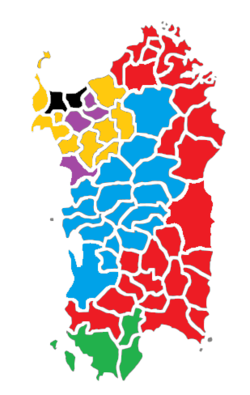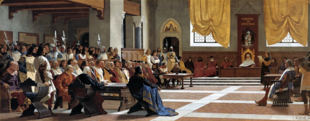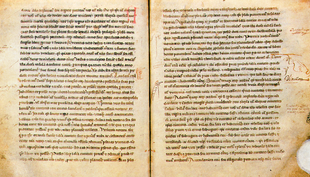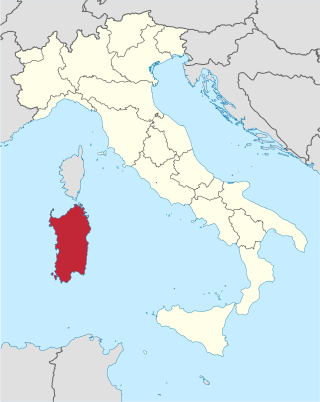
Sardinia is the second-largest island in the Mediterranean Sea, after Sicily, and one of the 20 regions of Italy. It is located west of the Italian Peninsula, north of Tunisia and immediately south of the French island of Corsica.
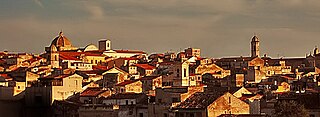
Sassari is an Italian city and the second-largest of Sardinia in terms of population with 127,525 inhabitants, and a Functional Urban Area of about 260,000 inhabitants. One of the oldest cities on the island, it contains a considerable collection of art.

Archaeological evidence of prehistoric human settlement on the island of Sardinia is present in the form of nuraghes and other prehistoric monuments, which dot the land. The recorded history of Sardinia begins with its contacts with the various people who sought to dominate western Mediterranean trade in classical antiquity: Phoenicians, Punics and Romans. Initially under the political and economic alliance with the Phoenician cities, it was partly conquered by Carthage in the late 6th century BC and then entirely by Rome after the First Punic War. The island was included for centuries in the Roman province of Sardinia and Corsica, which would be incorporated into the diocese of Italia suburbicaria in 3rd and 4th centuries.

Eleanor of Arborea or Eleanor De Serra Bas was one of the most powerful and important, and one of the last, judges of the Judgedom of Arborea in Sardinia, and Sardinia's most famous heroine. She is also known for updating of the Carta de Logu, promulgated by her father Marianus IV and revisited by her brother Hugh III.
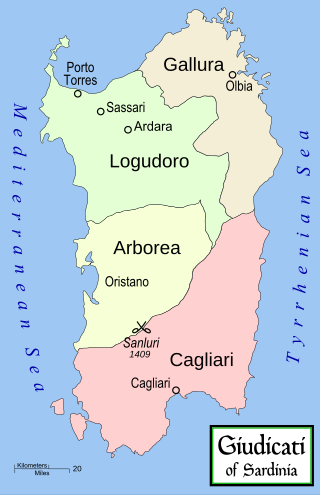
The Judicates, in English also referred to as Sardinian Kingdoms, Sardinian Judgedoms or Judicatures, were independent states that took power in Sardinia in the Middle Ages, between the ninth and fifteenth centuries. They were sovereign states with summa potestas, each with a ruler called judge, with the powers of a king.
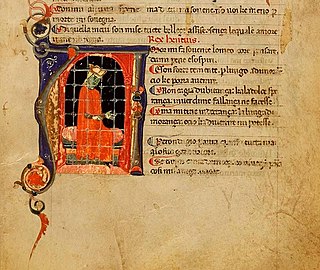
Enzo was an illegitimate son of the Hohenstaufen emperor Frederick II, who appointed him 'King of Sardinia' in 1238. He played a major role in the wars between Guelphs and Ghibellines in the Imperial kingdom of Italy, and was captured by his enemies in 1249. He remained imprisoned in Bologna until his death.

The Judicate of Arborea or the Kingdom of Arborea was one of the four independent judicates into which the island of Sardinia was divided in the Middle Ages. It occupied the central-west portion of the island, wedged between Logudoro to the north and east, Cagliari to the south and east, and the Mediterranean Sea to the west. To the north east and beyond Logudoro was located Gallura, with which Arborea had far less interaction. Arborea outlasted her neighbours, surviving well into the 15th century. The earliest known judicial seat was Tharros. The Judicate of Arborea at the times of its maximum expansion occupied the whole island's territory, except the cities of Alghero and Cagliari.

The Judicate of Logudoro or Torres was a state in northwest Sardinia from the tenth through the thirteenth century. Its original capital was Porto Torres. The region is still called Logudoro today.

Marianus IV, called the Great, was the Judge (king) of Arborea, kingdom in the island of Sardinia, from 1347 to his death. He was, as his nickname indicates, the greatest sovereign of Arborea. He was a legislator and a warrior whose reign saw the commencement of massive codification of the laws of his realm and incessant warfare with the Crown of Aragon. He was also a religious man, who had connections to Catherine of Siena. He was, in short, an "wise legislator, able politician, and valiant warrior."
Adelasia (1207–1259), was the Judge of Logudoro from 1236 and Judge of Gallura from 1238.

Marianus II was the Judge of Arborea from 1241 to his death. With skilled military action, he came to control more than half of the island of Sardinia. By his control of the vast central plains and the rich deposits of precious metals, he increased the riches of his Judicate and staved off the general economic decline affecting the rest of Europe at the time.
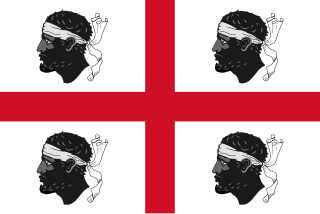
The Kingdom of Sardinia, also referred to as the Kingdom ofSardinia-Piedmont or Piedmont-Sardinia during the Savoyard period, was a state in Southern Europe from the late 13th until the mid 19th century.

The Nurra is a geographical region in the northwest of Sardinia, Italy. It is the second-largest plain of the island, located between the towns of Sassari, Porto Torres and Alghero. It covers a surface of 700 km² and is bounded by the Sardinian Sea on the west and by the Gulf of Asinara on the north.

The Goceano is a historical and geographical region of center-north of Sardinia island, Italy. It covers a surface of 480 km2 and has a population of 13,000 inhabitants. It is located inside the Province of Sassari, the main urban centres are Bono, Italy, considered the traditional Goceano's chieftown, Anela, Benetutti, Burgos, Bultei, Nule, Esporlatu, Illorai and Bottidda.

The Sardinians, or Sards, are a Romance language-speaking ethnic group native to Sardinia, from which the western Mediterranean island and autonomous region of Italy derives its name.

The Aragonese conquest of Sardinia took place between 1323 and 1326. The island of Sardinia was at the time subject to the influence of the Republic of Pisa, the Pisan della Gherardesca family, Genoa and of the Genoese families of Doria and the Malaspina; the only native political entity survived was the Judicate of Arborea, allied with the Crown of Aragon. The financial difficulties due to the wars in Sicily, the conflict with the Crown of Castile in the land of Murcia and Alicante (1296-1304) and the failed attempt to conquer Almeria (1309) explain the delay of James II of Aragon in bringing the conquest of Sardinia, enfeoffed to him by Pope Boniface VIII in 1297.

The Marquisate of Oristano was a marquisate of Sardinia that lasted from 1410 until 1478

The Sardinian–Aragonese war was a late medieval conflict lasting from 1353 to 1420. The fight was over supremacy of the land and took place between the Judicate of Arborea -- allied with the Sardinian branch of the Doria family and Genoa -- and the Kingdom of Sardinia, the latter of which had been part of the Crown of Aragon since 1324.
Francesco Cesare Casula is a Sardinian historian from Italy.

The Kingdom of Sardinia was a feudal state in Southern Europe created in the early 14 century and a possession of the Crown of Aragon first and then of the Spanish Empire.
